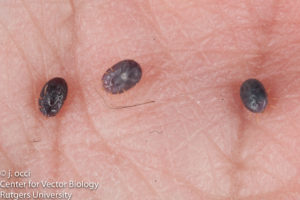
SHARE THIS ARTICLE:
James L. Occi, PhD: 4 New Published Articles on Ticks

James L. Occi, PhD, is the lead author of four new published articles regarding ticks over the last three years that have added to the scientific data necessary to understand the spread of ticks and the diseases they carry and transmit in the Northeast and that have provided a basis for moving the field of tick-borne diseases forward.
Jim has been on the Lyme Disease Association’s (LDA) Scientific & Professional Advisory Board since its inception in 1999. He has been an invaluable resource to the LDA providing lectures, blogs, tick images, and consultations on ticks and the diseases they carry.
LDA Congratulates James Occi (Jim), who recently received his PhD at Rutgers University, the Center for Vector Biology (New Brunswick), and wishes him every success with his future endeavors. He studied tick-borne diseases in New Jersey tick populations under the direction of Dr. Dina Fonseca and co-authored the below four published research articles for his dissertation.
“Annotated List of the Hard Ticks (Acari: Ixodida: Ixodidae) of New Jersey,” J Med Entomol., April 2019, examines documented cases of hard ticks found in NJ. After a thorough review of the scientific literature, government documents, and evaluation of tick collections (vouchers) in museums and other repositories, the authors determined there were 11 verifiable species of ticks found in NJ. Nine are native to North America, while two are invasive (Asian longhorned tick and brown dog tick). In addition, there are seven tick species that may be present or become established in the future, but confirmation with existing NJ vouchers was not found.
Five tick species were reviewed that were reported in NJ but not found in NJ vouchers or that were found within neighboring states. The importance of vouchers for tick research and surveillance is discussed.
A detailed statewide tick surveillance program would give public health professionals and physicians information to help protect the public from tick-borne diseases. They would be knowledgeable about what tick species were present, what the principal hosts were and what pathogens the ticks carry and transmit. (Click here for published article)
“New Jersey-Wide Survey of Rickettsia (Proteobacteria: Rickettsiaceae) in Dermacentor variabilis and Amblyomma americanum (Acari: Ixodida: Ixodidae)” was published in Am J Trop Med Hyg., Sept. 2020, and concludes the increase in Spotted Fever Group Rickettsioses (SFGR) in NJ is unlikely to come from D. variabilis. Infection with the tick-borne R. rickettsia bacterium causes Rocky Mountain spotted fever (RMSF) which can be fatal if left untreated.
Two tick species, that are considered Rickettsia vectors, were collected from all 21 NJ counties. 560 Dermacentor variabilis Say, American dog tick; 245 Amblyomma americanum L., lone star tick; and an additional 394 D. variabilis were collected at different time periods. Zero D. variabilis and zero A. americanum were found to be infected with Rickettsia rickettsia. They detected R. montanensis in D. variabilis and R. amblyommatis in A. americanum.
Collaboration among medical doctors, public health professionals, medical entomologists, and diagnostic laboratories will be needed to understand the causes of SFGR east of the Mississippi. What is causing human cases of SFGR in NJ remains unanswered. (Click here for published article)

“First Record of Carios kelleyi (Acari: Ixodida: Argasidae) in New Jersey, United States and Implications for Public Health,” J Med Entomol., March 2021. Carios kelleyi is a soft tick that is almost exclusively a parasite of bats and had been found in at least 29 states, Canada, Mexico, Costa Rica, Cuba, and now in New Jersey. The nymphs and adults take several short blood meals (min. to hrs.), while the larvae remain attached for several days. Relapsing fever Borrelia is known to come from soft ticks that feed on small rodents, and when bats are removed, ticks begin to seek blood meals from humans.
C. kelleyi has been found infected with a novel spotted fever Rickettsia; a novel relapsing fever-related Borrelia; Bartonella henselae; and a novel relapsing fever spirochete, identified as Borrelia johnsonii.
Although C. kelleyi is not thought to be an important vector of pathogens, its prevalence in bats in New Jersey is increasing. This creates the possibility for transmission to humans, animals, and livestock. New Jersey bats and the pathogens they carry should be monitored to assess the risk to the public. (Click here for published article)
“Ixodes scapularis (Ixodida: Ixodidae) Parasitizing an Unlikely Host: Big Brown Bats, Eptesicus fuscus (Chiroptera: Vespertilionidae), in New York State, USA,” was published in J Med Entomol, Jan. 2022. I. scapularis is a three-host tick found throughout the Northeast, Southeast, and Upper Midwest in the U.S and is the most common vector of tick-borne diseases to humans in North America. It feeds on over 150 species of terrestrial vertebrates, yet it had not previously been reported to feed on bats. During 2019 and 2020, injured big brown bats in four locations in rural NY had larvae and nymphs attached to them. Bats are known to carry a large number of pathogens and these ticks could go from hosting on a bat to hosting on a human. This poses a significant epidemiological risk and should be investigated further. It also threatens bat species that are at risk. (Click here for published article)





